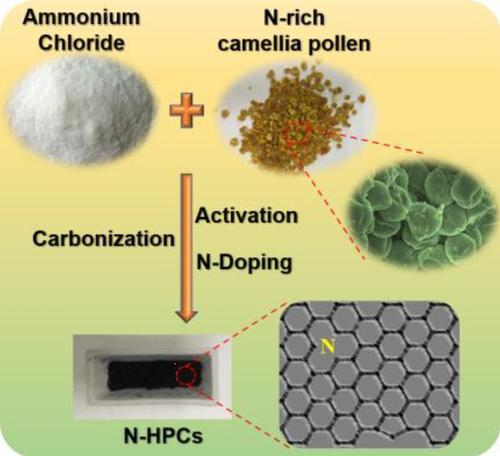当前位置:
X-MOL 学术
›
ChemNanoMat
›
论文详情
Our official English website, www.x-mol.net, welcomes your
feedback! (Note: you will need to create a separate account there.)
Camellia Pollen‐Derived Carbon with Controllable N Content for High‐Performance Supercapacitors by Ammonium Chloride Activation and Dual N‐Doping
ChemNanoMat ( IF 2.6 ) Pub Date : 2020-10-26 , DOI: 10.1002/cnma.202000531 Lihua Cao 1 , Huiling Li 1 , Zhaoxiu Xu 2 , Ruirui Gao 2 , Suqing Wang 2 , Guoying Zhang 3 , Shaohua Jiang 1, 3 , Wenhui Xu 4, 5 , Haoqing Hou 2
ChemNanoMat ( IF 2.6 ) Pub Date : 2020-10-26 , DOI: 10.1002/cnma.202000531 Lihua Cao 1 , Huiling Li 1 , Zhaoxiu Xu 2 , Ruirui Gao 2 , Suqing Wang 2 , Guoying Zhang 3 , Shaohua Jiang 1, 3 , Wenhui Xu 4, 5 , Haoqing Hou 2
Affiliation

|
Biomass‐derived carbon materials are an amazing electrode material for supercapacitor, owing to their abundant, porous structure and composition. Herein, a controllable N content carbon material with hierarchical porous structure was fabricated via an integrated carbonization, activation and nitrogen‐doping process. N‐rich camellia pollen is used as carbon precursor, while NH4Cl is employed as both activation agent and dopant. The optimal N‐doped carbon with higher N content (3.82 at%), suitable pore size distribution and larger specific surface area (810 m2 g−1), provides abundant ion transport channels and exposes more accessible active sites. Thus, a high specific capacitance of 280 F g−1 (1 A g−1) in 6 M KOH (three‐electrode system) can be obtained with making full use of N−HPC‐1. Moreover, the assembled symmetrical supercapacitor delivers high energy densities both in 6 M KOH (13.3 Wh kg−1) and 1 M Na2SO4 (20 Wh kg−1) that can be used for LED lighting. More than that, it is also demonstrates excellent cycle stability in 6 M KOH (85.4% after 20000 cycles at 20 A g−1). In view of the above‐mentioned merits, this N‐doped hierarchical porous carbon is anticipated to be a promising material for application in supercapacitors and other fields.
中文翻译:

通过氯化铵活化和双N掺杂对高性能超级电容器提供可控制N含量的山茶花粉衍生碳
由于生物质衍生的碳材料丰富,多孔的结构和成分,它们是超级电容器的绝佳电极材料。在此,通过集成的碳化,活化和氮掺杂工艺制备了具有可控的,具有分级多孔结构的N含量碳材料。富含N的山茶花粉被用作碳前体,而NH 4 Cl被用作活化剂和掺杂剂。具有较高N含量(3.82 at%),合适的孔径分布和较大的比表面积(810 m 2 g -1)的最佳N掺杂碳,提供了丰富的离子传输通道,并暴露了更易接近的活性位点。因此,具有280 F g -1(1 A g -1)充分利用N-HPC-1可以得到6 M KOH(三电极系统)。此外,组装好的对称超级电容器在6 M KOH(13.3 Wh kg -1)和1 M Na 2 SO 4(20 Wh kg -1)中都可提供高能量密度,可用于LED照明。不仅如此,它还表现出了在6 M KOH中的出色循环稳定性(在20 A g -1下20000次循环后为85.4%)。鉴于上述优点,这种N掺杂的分级多孔碳有望成为在超级电容器和其他领域中应用的有前途的材料。
更新日期:2020-10-26
中文翻译:

通过氯化铵活化和双N掺杂对高性能超级电容器提供可控制N含量的山茶花粉衍生碳
由于生物质衍生的碳材料丰富,多孔的结构和成分,它们是超级电容器的绝佳电极材料。在此,通过集成的碳化,活化和氮掺杂工艺制备了具有可控的,具有分级多孔结构的N含量碳材料。富含N的山茶花粉被用作碳前体,而NH 4 Cl被用作活化剂和掺杂剂。具有较高N含量(3.82 at%),合适的孔径分布和较大的比表面积(810 m 2 g -1)的最佳N掺杂碳,提供了丰富的离子传输通道,并暴露了更易接近的活性位点。因此,具有280 F g -1(1 A g -1)充分利用N-HPC-1可以得到6 M KOH(三电极系统)。此外,组装好的对称超级电容器在6 M KOH(13.3 Wh kg -1)和1 M Na 2 SO 4(20 Wh kg -1)中都可提供高能量密度,可用于LED照明。不仅如此,它还表现出了在6 M KOH中的出色循环稳定性(在20 A g -1下20000次循环后为85.4%)。鉴于上述优点,这种N掺杂的分级多孔碳有望成为在超级电容器和其他领域中应用的有前途的材料。











































 京公网安备 11010802027423号
京公网安备 11010802027423号